Main content starts here.
Foreign Languages > Chiba International Information Square - To foreign residents - > Chiba Nanohana News > Chiba Nanohana News (Past Issues) > Chiba Nanohana News (June 2021)
Update: June 19, 2024
Chiba Nanohana News (June 2021)
Index
I. News
1)Reinforced Preventative Measures against COVID-19 Extended until July 11
The Prefecture has extended the duration for reinforced preventative measures against COVID-19 until July 11. The areas under these preventative measures have also changed.
Please continue taking proper safety measures to prevent the spread of COVID-19.
- Duration: April 20, 2021 (Tues) - July 11, 2021 (Sun)
- Areas: Chiba City, Ichikawa City, Funabashi City, Kisarazu City, Matsudo City, Narashino City, Ichihara City, Kimitsu City, Futtsu City, Urayasu City, Sodegaura City
2) Food Poisoning Alert Issued
As temperatures rise, bacteria becomes more prevalent and many cases of food poisoning caused by bacteria occur. Close attention must be particularly paid to food poisoning caused by infections such as Campylobacter, E. coli 0157, etc. due to consuming raw or undercooked meat. In response to this, the Prefecture has issued a “Food Poisoning Alert” effective June 1 to remind all residents to take thorough measures to prevent food poisoning.
The three principles to prevent food poisoning are: Prevent bacteria, don’t increase bacteria, and kill bacteria. Food poisoning can be prevented by paying attention to the following.
Prevent bacteria
- Always wash your hands before cooking or eating.
- Food poisoning can be caused by bacteria in raw meat. Make sure to use a different utensil for handling raw meat and for eating.
Don’t increase bacteria
- Keep your refrigerator temperature under 10 degrees Celsius and your freezer under -15 degrees Celsius.
- Avoid leaving food out at room temperature for long periods of time before or after cooking.
Kill bacteria
- Make sure foods such as meat and fish are fully cooked (75 degrees Celsius, more than 1 min.)
- Use boiling water to disinfect all utensils that were used to handle raw foods such as meat and fish.
Food Poisoning Alert Issued / Chiba Prefecture Public Health Guidance Division
3) Reinforced Preventative Measures against COVID-19 Extended until June 20
The Prefecture has extended the duration for reinforced preventative measures against COVID-19 until June 20. Please continue taking proper safety measures to prevent the spread of COVID-19.
Duration: April 20, 2021 (Tues) - June 20, 2021 (Sun)
4) Multilingual Coronavirus Consultation
Chiba Prefecture has established a multilingual coronavirus consultation hotline. Call this hotline if you are worried you might have coronavirus for a consultation. Interpretation is available in 17 languages. Please state your preferred language when you call.
Coronavirus Consultation Hotline TEL: 050-3623-2395
Languages available: English, Chinese, Cantonese, Korean, Vietnamese, Portuguese, Spanish, Russian, Thai, Hindi, French, Mongolian, Tagalog, Nepali, Bahasa Indonesia, Farsi, and Burmese
※If you would like a consultation in Japanese, please call the number below.
Chiba Prefecture Fever Consultation Call Center TEL: 0570-200-139
In addition, a chatbot service for inquiries about COVID-19 in Chiba Prefecture is available in multiple languages.
For consultations about vaccinations, please call the Ministry of Health, Labour and Welfare COVID-19 Call Center (TEL: 0120-761-770; multilingual support available).
For inquiries about matters other than COVID-19 such as daily life and family, work and school, money and housing, ETC., please call the Chiba Advisory Service for Foreign Residents (TEL: 043-297-2966; multilingual support available).
II. Charm of Chiba
1) Seasonal Flowers
In the U.S. there is a saying, “April showers bring May flowers.” Though the timeline is a little different from Chiba’s June rainy season, the sentiment of rain bringing flowers is the same. Though the rainy season is not a popular one, it is a beautiful time of year in which many water-loving plants bloom. Here are some of the best places in Chiba to see flowers like irises and hydrangeas.
※ Please go out only during appropriate times in accordance with the COVID-19 situation. (When going out, please be sure to wear a mask and take other COVID-19 countermeasures.)
Suigo Sawara Iris Festival at Suigo Sawara Ayame Park (Katori City)
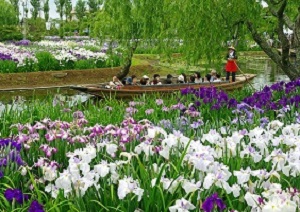
Suigo Sawara Ayame Park is famous for its “hanashobu” (Japanese irises). The gorgeous purple colors of 1.5 million irises of 400 varieties in full bloom stretch across the park and will be celebrated at the Suigo Sawara Iris Festival until Sunday, June 27.
- Date: Saturday, May 29 - Sunday, June 27, 8:00-18:00
- Location: Suigo Sawara Ayame Park / 1837-2, Ogishima, Katori City
- Admission: Adults 800 yen, age 65 and older 700 yen, Junior high and elementary school students 400 yen (during the festival)
- Access: 25 min. by shuttle bus from Sawara Station (JR Narita Line)
*The shuttle bus only runs until June 20 and costs 500 yen for junior high school students and above, 250 yen for elementary school students, and free for pre-school age children. - Inquiries: Suigo Sawara Ayame Park TEL: 0478-56-0411
Hondoji Temple (Matsudo City)
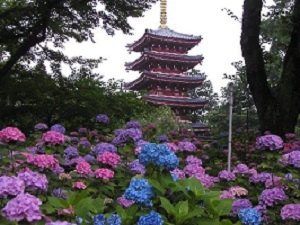
Hondoji, built in 1277, is a temple which practices the Nichiren school of Buddhism and is known by its nickname, “Hydrangea Temple.” At the start of summer, the temple grounds become completely enveloped in a beautiful array of hydrangeas.
- When to go: Late May - late June
- Location: 63 Hiraga, Matsudo City
- Admission: Junior high school students and above 500 yen, Elementary school and under free
- Access: 10 min. walk from Kitakogane Station (JR Joban Line)
- Inquiries: TEL: 047-341-0405 (telephone services limited to June and November)
- URL: Hondoji Temple

Sogo Mausoleum (Narita City)
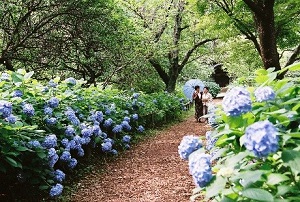
On the grounds behind the main Sogo Mausoleum, a wide variety of over 7,000 hydrangeas are available for visitors to enjoy. A hydrangea festival is being held every Sunday from June 6 to June 27.
- When to go: Mid-June - early July
- Location: 1-558 Sogo, Narita City
- Access: 20 min. walk from Keisei Sogo Sando Station
- Inquiries: Narita City Tourism Association TEL: 0476-22-2102
Fureai Hydrangea Road (Asahi City)
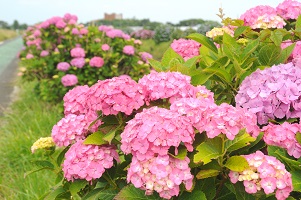
This is a colorful 2km walking course along the Nittama River that flows through Asahi City where you can see about 1,500 hydrangeas in full bloom.
- When to go: Early - late June
- Location: Nittama, Asahi City
- Access: 15 min. walk from Asahi Station (JR Sobu Line)
- Inquiries: Asahi City Commerce, Industry, and Tourism Division TEL: 0479-62-5338
Hattori Farm Hydrangea House (Mobara City)
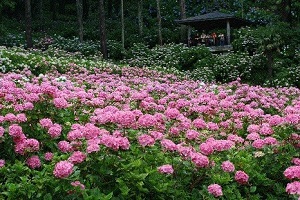
More than 10,000 hydrangeas of 250 varieties have been planted on a total area of 18,000 square meters. During hydrangea season from early June to early July, the mountainside is covered with colorful hydrangeas from top to bottom.
- When to go: June 1 - early July (open every day 8:00-18:00 during this period)
- Admission: Adults (junior high school students and above) 500 yen, Children (elementary school students) 200 yen
- Location: 719 Sangaya, Mobara City
- Access: 20 min. by car from the Mobara-Chonan Interchange on the Ken-O Expressway; 10 min. by taxi from Mobara Station (JR Sotobo Line)
-
Inquiries: Hattori Farm Hydrangea House TEL: 0475-24-8511
Mamenbara Plateau (Otaki Town)
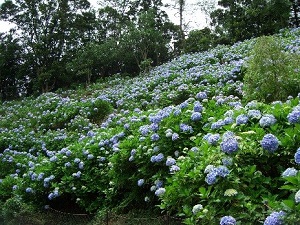
Hydrangeas that bloom on Mamenbara-kogen, a 340m plateau, can be enjoyed from early July. At the top of the plateau lies Myohoshoji Temple, nicknamed the “Hydrangea Temple,” where a monk began planting hydrangeas in 1951. Now, over 20,000 blue hydrangeas bloom down the hillside.
- When to go: Early - mid July
- Location: Around Tsutsumori, Otaki Town
- Access: About 60 min. by car from the Ichihara Tsurumai Interchange on the Ken-O Expressway via Route 178
- Inquiries: Otaki Town Tourism Association TEL: 0470-80-1146
Nihonji Temple (Kyonan Town)
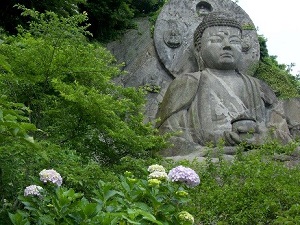
1,300 years ago, upon receiving orders from Emperor Shomu, the monk Gyoki opened this temple, making it the oldest place of imperial worship in Kanto region. Within the temple grounds, along with the housing Japan’s largest rock-carved Buddha, a wide variety of tourist attractions can be found. Over 20,000 hydrangea flowers are blooming on the temple grounds.
- When to go: Late June
- Location: 184 Motona, Kyonan Town
- Time: 8:00 - 17:00
- Admission: Adults 700 yen, Children 400 yen
-
Access: 7 min. walk from Hamakanaya Station (JR Uchibo Line) to the ropeway; 5 min. walk from the summit after getting off the ropeway; 5 min. by car from the Tateyama Roadway Kyonan Hota Interchange to the East Exit free parking lot
- Inquiries: Nihonji Temple TEL: 0470-55-1103
2) Chiba’s Dairy Farming
The Food and Agriculture Organization of the United Nations (FAO) has designated June 1st as “World Milk Day” with the aim of raising awareness of milk and at the same time making the dairy industry known to as many people as possible. The Japan Dairy Association has also designated June 1st as “Milk Day” and June as “Dairy Month” in Japan.
It is said that Chiba Prefecture is the birthplace of Japanese dairy farming! There are 522 dairy farms and 28,600 dairy cattle in the Prefecture, yielding about 190,000 tons of fresh milk, ranking 6th in the country and 5th in Japan for its output value of 22.6 billion yen (2019). In addition, Chiba Prefecture, located in the Tokyo metropolitan area, has the advantage of being able to quickly deliver fresh milk to households in Tokyo and other large consumption areas.


<Chiba’s Dairy Farming History>
During the Edo period, the 8th shogun, Tokugawa Yoshimune, promoted the development of pastures, and in 1728, he raised three white cows possibly from India in Mineoka Pasture in Chiba Prefecture (today’s Minamiboso City) to produce “hakugyuraku” (like butter today).
At the time, hakugyuraku was valued for its medicinal properties along with milk.
It is said that this was the beginning of dairy farming in Japan. In 1963, the Mineoka area (Minamiboso City) was designated as a Chiba Prefecture historic site as the birthplace of Japanese dairy farming.
Today, the Mineoka Milk Research Institute of the Chiba Prefectural Livestock Research Center is located here. As the “Chiba Prefecture Rakuno-no-Sato (Dairy Farming Village),” visitors can interact with goats in the pasture. Visitors can also see the cute, white cows, which are the symbol of the birthplace of dairy farming and can only be seen here!
Chiba Prefecture Rakuno-no-Sato (Japanese)
<Milk Varieties>
About 98% of milk in Japan is produced from the black and white patterned Holstein breed. Holstein cows are a dairy breed that were imported to Japan during the Meiji era, and is widely bred around the world. This breed originates from the Friesian region of the Netherlands, a low marshy area at the mouth of the Rhine River, and the Holstein region of Germany, which is what it was named after.
Holstein cows have a gentle disposition and are easy to breed and have an extremely high milk capacity of 6,000-8,000 kg of milk per year. Among these there are “super cows” which can produce over 20,000 kg of milk in a year. This milk has a fat content of 3-4%, and its carotene is converted into vitamin A and released into the milk, making its color white with a yellowish tinge.
<Making Delicious Milk>
Milk is very nutritious, so it is easy for bacteria to grow in it; meticulous care is taken to control its quality. First, milking is very hygienic and is produced from strong, healthy cows. The milk is refrigerated as soon as it sent to the tank via pipeline without being exposed to the outside air. After that, the milk is transported to the factory where it is tested for flavor, milk composition, relative density, bacteria count, etc. Only the milk that passes these tests go into our mouths!
Milk / Reference book / Chiba Prefecture Distribution and Marketing Division (Japanese)
※ < Decorative Monorail Promoting Milk Consumption in Operation!>
The Chiba Urban Monorail has been in operation from this April with the aim of promoting milk. You can also see a picture of CHI-BA+KUN holding a glass of milk! Please check it out!

|
|
|
